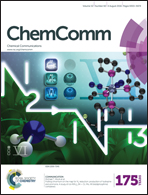Recent advances in pillar[n]arenes: synthesis and applications based on host–guest interactions
Abstract
Pillar[n]arenes (n = 5–15) are a novel class of macrocyclic molecules with hydroquinone as the repeating unit linked by methylene bridges at para-positions. Introduced by T. Ogoshi for the first time in 2008, pillararenes have attracted increasing interest and have been widely studied during the last eight years, due to their unique structural advantages as host molecules, such as symmetrical rigid architecture, electron-rich cavities and facile functional modification. In this review, we first describe the syntheses of pillar[n]arenes including cyclooligomerization of pillar[n]arenes and modification of pillar[n]arenes after cyclooligomerization, summarising almost twenty different kinds of guest motifs and dividing them into three types: cationic, neutral and anionic motifs. The main section of this review examines the applications of pillar[n]arenes based on the host–guest interactions in different research fields, including biology, materials science and environmental science. Finally, future research directions and potential for novel applications are discussed.
![Graphical abstract: Recent advances in pillar[n]arenes: synthesis and applications based on host–guest interactions](/en/Image/Get?imageInfo.ImageType=GA&imageInfo.ImageIdentifier.ManuscriptID=C6CC03641D&imageInfo.ImageIdentifier.Year=2016)
- This article is part of the themed collection: Host–guest chemistry

 Please wait while we load your content...
Please wait while we load your content...